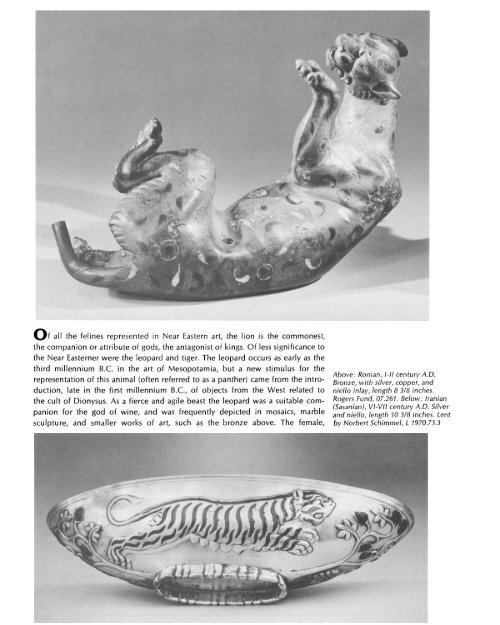The Metropolitan Museum of Art Bulletin, v. 29, no. 7 (March, 1971)
The Metropolitan Museum of Art Bulletin, v. 29, no. 7 (March, 1971)
The Metropolitan Museum of Art Bulletin, v. 29, no. 7 (March, 1971)
Create successful ePaper yourself
Turn your PDF publications into a flip-book with our unique Google optimized e-Paper software.
Of all the felines represented in Near Eastern art, the lion is the commonest,<br />
the companion or attribute <strong>of</strong> gods, the antagonist <strong>of</strong> kings. Of less significance to<br />
the Near Easterner were the leopard and tiger. <strong>The</strong> leopard occurs as early as the<br />
third millennium B.C. in the art <strong>of</strong> Mesopotamia, but a new stimulus for the<br />
representation <strong>of</strong> this animal (<strong>of</strong>ten referred to as a panther) came from the introduction,<br />
late in the first millennium B.C., <strong>of</strong> objects from the West related to<br />
the cult <strong>of</strong> Dionysus. As a fierce and agile beast the leopard was a suitable companion<br />
for the god <strong>of</strong> wine, and was frequently depicted in mosaics, marble<br />
sculpture, and smaller works <strong>of</strong> art, such as the bronze above. <strong>The</strong> female,<br />
Above: Roman, I-II century A.D.<br />
Bronze, with silver, copper, and<br />
niello inlay, length 8 3/8 inches.<br />
Rogers Fund, 07.261. Below: Iranian<br />
(Sasanian), VI-VII century A.D. Silver<br />
and niello, length 10 3/8 inches. Lent<br />
by Norbert Schimmel, L 1970.73.3

















